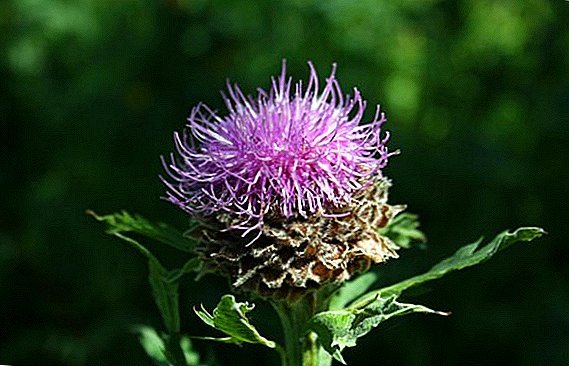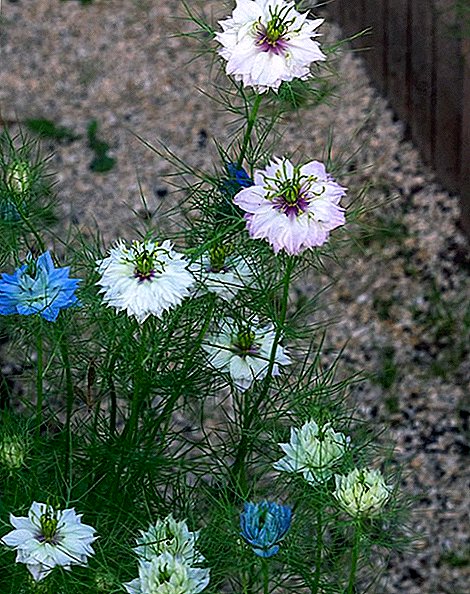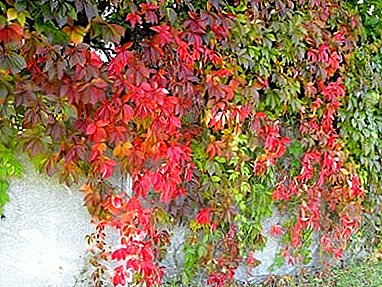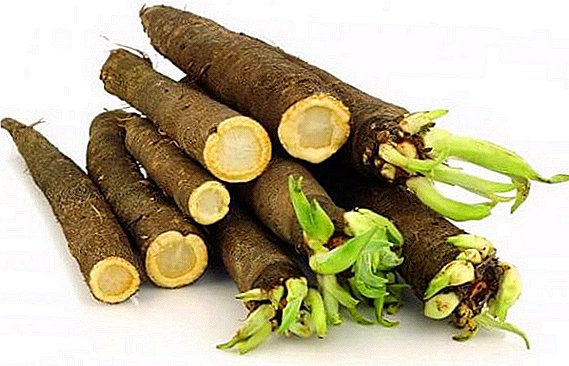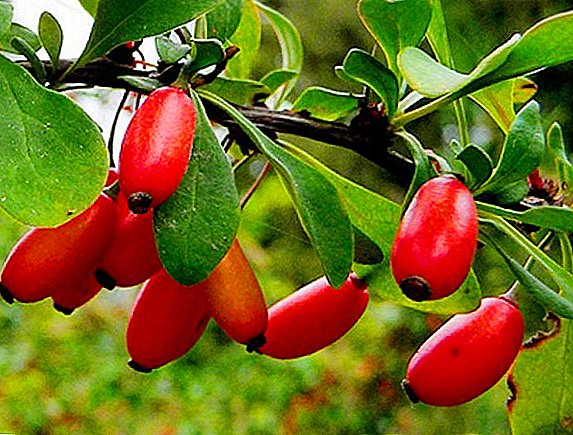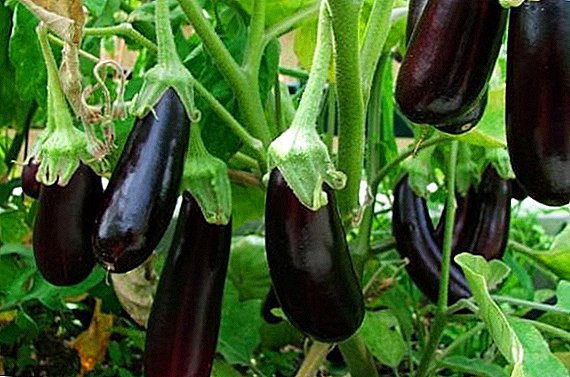 The market offers a huge number of varieties of eggplants, and one of the most popular today is the hybrid variety "Valentine F1".
The market offers a huge number of varieties of eggplants, and one of the most popular today is the hybrid variety "Valentine F1".
In this article we will tell you what this variety earned trust and why it became the number 1 choice for all professional gardeners and gardeners.
Eggplant variety "Valentine F1"
"Valentine F1" - the earliest variety of eggplant, which bears fruit already on the 60th day after sowing in the ground. Grows and gives a high yield in a variety of weather and climatic conditions.
The bush reaches a height of 85 cm, strong, does not need to be tied up and is resistant to diseases.  Fruits up to 25 cm long, and up to 6 cm wide, saturated black-violet color, with high taste, weighing 200-250 g. White-colored flesh is characterized by the absence of seeds and bitterness in taste.
Fruits up to 25 cm long, and up to 6 cm wide, saturated black-violet color, with high taste, weighing 200-250 g. White-colored flesh is characterized by the absence of seeds and bitterness in taste.
Did you know? Everyone is accustomed to consider eggplant as a vegetable fruit, but it turns out that it is a berry, just like a watermelon.
Choice of place and predecessors of culture
This plant is quite unpretentious, but the best yield will give, subject to certain rules and regulations of planting.
Lighting
In the greenhouse, eggplants feel better and produce a high yield. But a well-heated and lit throughout the day open area is also suitable. In the shade or partial shade of the bushes will be small, and the size of the fruit is smaller compared to the standard. 
The soil
When planting eggplants for seedlings, the best option would be to buy soil for solanaceous plants, but the following mixture is perfect:
- 4 pieces of compost;
- 2 parts peat;
- 1 part wood chips;
- 0.5 parts wood ash.
 1. For clayey or loamy:
1. For clayey or loamy:- compost - 1 bucket;
- sand - 1 bucket;
- peat -2 buckets;
- sawdust - 0.5 buckets.
- 3 buckets of clay soil;
- 2 compost and peat buckets;
- 1 bucket of sawdust.
- 1 bucket of turf;
- 1 bucket of sand;
- 1 bucket of humus.
The best predecessors on the site are carrots, legumes, greens or melons and gourds. It is better not to plant eggplants in the beds where potatoes, peppers and tomatoes were grown.
Did you know? Eggplant in English "eggplant" means "plant-egg". This is due to the fact that the first eggplants seen were round and white. And for the similarity with the chicken egg, the plant was so named.
How to plant seeds
Timing and preparation
Terms of planting eggplant seeds directly depend on climatic conditions, but, as a rule, it is already possible to sow in the beginning or middle of March. Seeds before sowing must be stratified, and hydrogen peroxide in the form of an aqueous solution is best coped with this. To do this, one day before sowing 5 drops of peroxide, dilute it with a glass of water and soak the seeds for 15-20 minutes. The germinated seeds of eggplant can boast the best germination. To germinate them, it is enough to wrap them in a damp cloth, put them in a warm and darkened place and from time to time sprinkle them with water. After a couple of days, it is already possible to sow sunflower seeds.
Sowing scheme
Sow better in peat or plastic cups, each seed in a separate cup. Put it on the bottom compacted with soil and sprinkle with soil 0.5 cm. Eggplants have a very delicate root system and they have a bad attitude to transplanting, so pick up the container so as to avoid diving.
For hulled seeds, hardening is perfect when a centimeter layer of snow is poured over the cups. But be careful, since for already germinated seeds this cannot be done, but only by pouring it with thawed or settled water. And maintain them at a constant temperature from +25 ° C to +28 ° C. 
Rules for the care of seedlings and the subsequent landing in the ground
The way you care for seedlings will directly affect the further development and yield of the plant. The ideal temperature for eggplant seedlings is + 22-28 ° C, and in the first two weeks at night you need to lower the temperature to + 17-18 ° C. This temperature change is necessary so that the plants do not stretch.
Important! If planting is carried out in a greenhouse, then the maximum level of humidity should be no more than 70%. If it is exceeded, the eggplant "Valentine F1" drops the leaves, and the subsequent harvest will be very poor.Watering is carried out in two days with thawed or separated soft water with a temperature not lower than +20 ° C. From time to time, antifungal agents such as Gaupsin, Fundazol or Trichodermin can be added to the water for irrigation.
During watering it is important to carefully check the germs for the presence of insect pests. If there are any signs of their appearance, immediately treat the seedlings with any bioinsecticide, for example, "Fitoverm", "Iskra" or "Aktara".  Eggplants are quite slow in growth, and they will need fertilizing, which is carried out with irrigation, but after the appearance of the first two or three leaves. 10 g of urea or 30 g of nitroammophoska complete with 30 g of superphosphate is dissolved in 10 l of water.
Eggplants are quite slow in growth, and they will need fertilizing, which is carried out with irrigation, but after the appearance of the first two or three leaves. 10 g of urea or 30 g of nitroammophoska complete with 30 g of superphosphate is dissolved in 10 l of water.
A very important point in the care of seedlings is the proper hardening of the shoots. Two weeks before the landing on the site we take out the seedlings on the balcony or in the garden for a couple of hours after dinner.
Every day we increase the time of walking in the fresh air by an hour. When the sprouts are straight, from 17 cm in height, with six to eight leaves and a sufficiently developed root system, you can start planting our seedlings.
Landing is carried out in the evening when there is no strong wind. The beds under the eggplants dig up, level and make holes 12-15 cm deep. Planted bushes at a distance of 45-55 cm from each other. It is better to land the ground around the bush with needles or dry grass, and put a black film between the rows in order to avoid moisture evaporation.
Features of care and cultivation
Top dressing and watering
The first dressing should be carried out 15-20 days after disembarkation of eggplants. On 10 l of water we part:
- 50 g of superphosphate;
- 15 g of ammonium nitrate;
- 20 g of potassium salt.
For the season it is enough to spend three dressings to get the best harvest. For better effect, types of dressings can be alternated.
Do not water the plants for the first few weeks after planting, as this will contribute to dropping the leaves. In the greatest amount of moisture eggplants need in the period of fruit ovary. Water should be warm, not lower than 22 ° C, and watering is important at the root, avoiding contact with the leaves. 
Forming a bush
Eggplant varieties "Valentine F1" does not need special pruning or shaping. Enough to carry out sanitary pruning, removing dried shoots and leaves. If you see that the bush has grown strongly and is bending under its weight, then it is better to tie it up, leaving room for further growth.
Soil care
If the soil was not mulched, then it is necessary to loosen it regularly, avoiding the formation of a crust on the ground, and remove weeds in a timely manner. It is important to regularly break through the ground during active growth, so the earth warms better with the sun.
Important! Eggplants are a favorite delicacy of the Colorado beetles, which can eat everything in a matter of days: from leaves to flowers and ovaries. Therefore, you need to collect them daily or treat them with insecticide from these pests.
When to harvest
And two months will not pass, as the time comes to harvest the first harvest. Then the fruit will reach its optimum mass - about 200 g - and will get a pear-shaped form and a rich shade. 
Advantages and disadvantages of the variety
Among the main advantages are the following:
- earlier ripening, and at the end of July you can try the first harvest;
- high quality of fruits with a smooth thin sandpaper of rich black and purple color;
- disease resistance;
- practically do not contain seeds and do not gorchat, which is very convenient in cooking;
- in length can reach 25 cm, and weight - up to 220 g;
- the bush is strong and does not need formation and a garter;
- Yield is about 3.5 kg per meter of planting.
 There are few disadvantages of this variety, and among the main ones there is poor germination of seeds. But, as a rule, it is connected with their incorrect sowing.
There are few disadvantages of this variety, and among the main ones there is poor germination of seeds. But, as a rule, it is connected with their incorrect sowing.With proper care for the eggplant variety "Valentine F1" indicated in the description, the plants will thank you for the high harvest, which you will be proud of.


